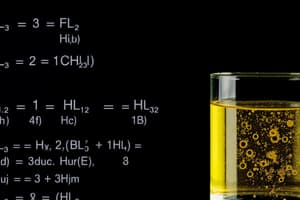Podcast
Questions and Answers
Consider a closed system containing initially only diatomic hydrogen and oxygen gases. Under what precise conditions, considering temperature, pressure, and the presence of specific catalysts, will the reaction $2H_2(g) + O_2(g) \rightleftharpoons 2H_2O(g)$ proceed such that the equilibrium mixture contains no detectable unreacted oxygen, assuming ideal gas behavior and perfect mixing?
Consider a closed system containing initially only diatomic hydrogen and oxygen gases. Under what precise conditions, considering temperature, pressure, and the presence of specific catalysts, will the reaction $2H_2(g) + O_2(g) \rightleftharpoons 2H_2O(g)$ proceed such that the equilibrium mixture contains no detectable unreacted oxygen, assuming ideal gas behavior and perfect mixing?
- Under standard conditions ($298 \mathrm{K}$, $1 \mathrm{atm}$) with a platinum catalyst; the reaction will invariably proceed to completion due to thermodynamic favorability.
- With a stoichiometric excess of hydrogen at moderate temperatures ($500-700 \mathrm{K}$) and optimized pressure using a palladium catalyst, followed by immediate product removal to shift equilibrium. (correct)
- At extremely high temperatures ($>2000 \mathrm{K}$) and pressures ($>100 \mathrm{atm}$) in the absence of any catalyst to overcome kinetic barriers, ensuring all oxygen is consumed.
- Under cryogenic conditions (near absolute zero) to suppress the reverse reaction, combined with intense UV irradiation to initiate homolytic cleavage of $O_2$ and subsequent rapid reaction with $H_2$.
Given the reaction $AgNO_3(aq) + NaCl(aq) \rightarrow AgCl(s) + NaNO_3(aq)$, under what non-standard conditions (i.e., deviating from $25^\circ C$ and 1 atm) would the apparent equilibrium constant ($K_{app}$) be most significantly affected, considering activity coefficients and complex ion formation?
Given the reaction $AgNO_3(aq) + NaCl(aq) \rightarrow AgCl(s) + NaNO_3(aq)$, under what non-standard conditions (i.e., deviating from $25^\circ C$ and 1 atm) would the apparent equilibrium constant ($K_{app}$) be most significantly affected, considering activity coefficients and complex ion formation?
- High ionic strength solutions (e.g., $1 M$ $KNO_3$) where the Debye-Hckel theory accurately predicts activity coefficient changes, leading to a predictable shift in $K_{app}$.
- Supercooled solutions far below the freezing point of water, drastically reducing ion mobility and thus slowing down both the forward and reverse reaction rates equally, leaving $K_{app}$ unchanged.
- Extremely dilute solutions ($<10^{-6} M$), where ion pairing is negligible and activity coefficients approach unity, thereby minimizing deviations from ideality.
- Solutions with a significant concentration of ammonia ($NH_3$), facilitating the formation of silver ammine complexes ($[Ag(NH_3)_2]^+$), thereby increasing the apparent solubility of $AgCl$. (correct)
In the context of redox reactions, consider a scenario where elemental iron ($Fe$) is immersed in a copper sulfate ($CuSO_4$) solution. What specific alteration to the solution's propertiesbeyond simple concentration changeswould most effectively suppress the spontaneous displacement reaction, $Fe(s) + CuSO_4(aq) \rightarrow FeSO_4(aq) + Cu(s)$, based on electrochemical principles?
In the context of redox reactions, consider a scenario where elemental iron ($Fe$) is immersed in a copper sulfate ($CuSO_4$) solution. What specific alteration to the solution's propertiesbeyond simple concentration changeswould most effectively suppress the spontaneous displacement reaction, $Fe(s) + CuSO_4(aq) \rightarrow FeSO_4(aq) + Cu(s)$, based on electrochemical principles?
- Saturating the solution with an inert salt (e.g., $Na_2SO_4$) to increase the ionic strength, minimizing the activity coefficients of the redox-active ions and thus inhibiting electron transfer.
- Increasing the temperature to near boiling, thereby enhancing the kinetic energy of the ions and favoring the reverse reaction due to Le Chatelier's principle.
- Applying an external potential using a potentiostat to maintain the iron electrode at a more positive potential than its standard reduction potential, effectively reversing the driving force of the reaction. (correct)
- Introducing a strong chelating agent (e.g., EDTA) that selectively binds with $Fe^{2+}$ ions, significantly lowering their concentration in solution and shifting the equilibrium to favor the reactants.
Given the balanced chemical equation $2H_2 + O_2 \rightarrow 2H_2O$, performed under non-ideal conditions where the activity coefficients of the reactants and products deviate significantly from unity, how would one accurately determine the Gibbs Free Energy change ($\Delta G$) for this reaction at a specific non-standard state, accounting for these non-idealities?
Given the balanced chemical equation $2H_2 + O_2 \rightarrow 2H_2O$, performed under non-ideal conditions where the activity coefficients of the reactants and products deviate significantly from unity, how would one accurately determine the Gibbs Free Energy change ($\Delta G$) for this reaction at a specific non-standard state, accounting for these non-idealities?
Consider a complex reaction mechanism involving multiple elementary steps, where the rate-determining step exhibits a significant kinetic isotope effect (KIE) when deuterium ($D$) is substituted for protium ($H$). How would this KIE quantitatively impact the observed overall reaction rate, and what specific experimental technique could unequivocally confirm that the measured KIE corresponds exclusively to the rate-determining step?
Consider a complex reaction mechanism involving multiple elementary steps, where the rate-determining step exhibits a significant kinetic isotope effect (KIE) when deuterium ($D$) is substituted for protium ($H$). How would this KIE quantitatively impact the observed overall reaction rate, and what specific experimental technique could unequivocally confirm that the measured KIE corresponds exclusively to the rate-determining step?
Flashcards
Chemical Reaction
Chemical Reaction
Transformation of reactants into products with a change in composition.
Balanced Chemical Equation
Balanced Chemical Equation
An equation with equal numbers of each atom on both sides, obeying mass conservation.
Redox Reaction
Redox Reaction
A reaction involving the transfer of electrons between two substances.
Displacement Reaction
Displacement Reaction
Signup and view all the flashcards
Example of a Redox Reaction
Example of a Redox Reaction
Signup and view all the flashcards
Study Notes
Chemical Reactions and Equations
- A chemical reaction is a process where reactants change into products with a change in chemical composition. Example: 2H₂ + O₂ → 2H₂O (Formation of water).
- A balanced chemical equation ensures the law of conservation of mass is followed. It has an equal number of atoms of each element on both sides of the equation.
- Redox reactions involve a transfer of electrons. An example of a redox reaction is: H₂ + Cl₂ → 2HCl.
- Displacement reactions involve one element replacing another in a compound. Example: Fe + CuSO₄ → FeSO₄ + Cu.
Studying That Suits You
Use AI to generate personalized quizzes and flashcards to suit your learning preferences.



